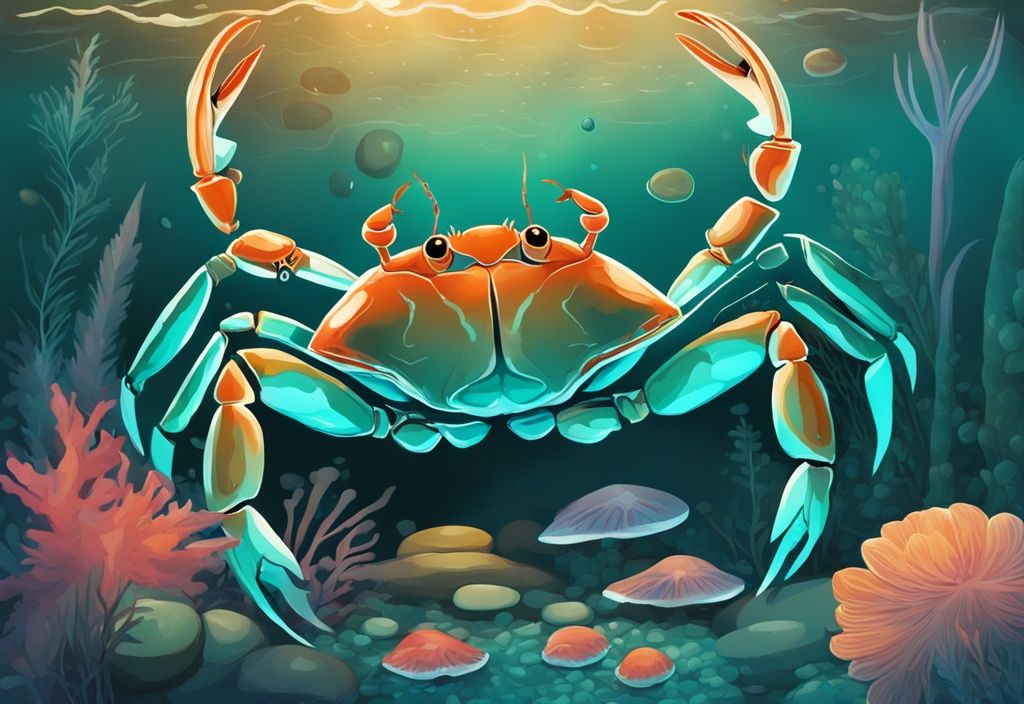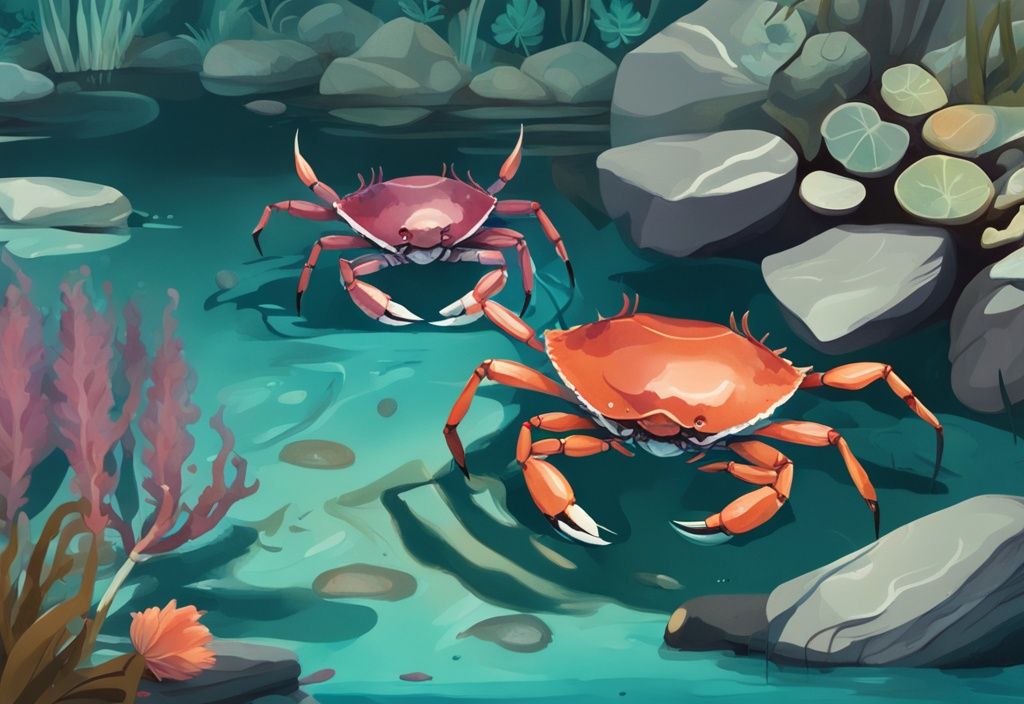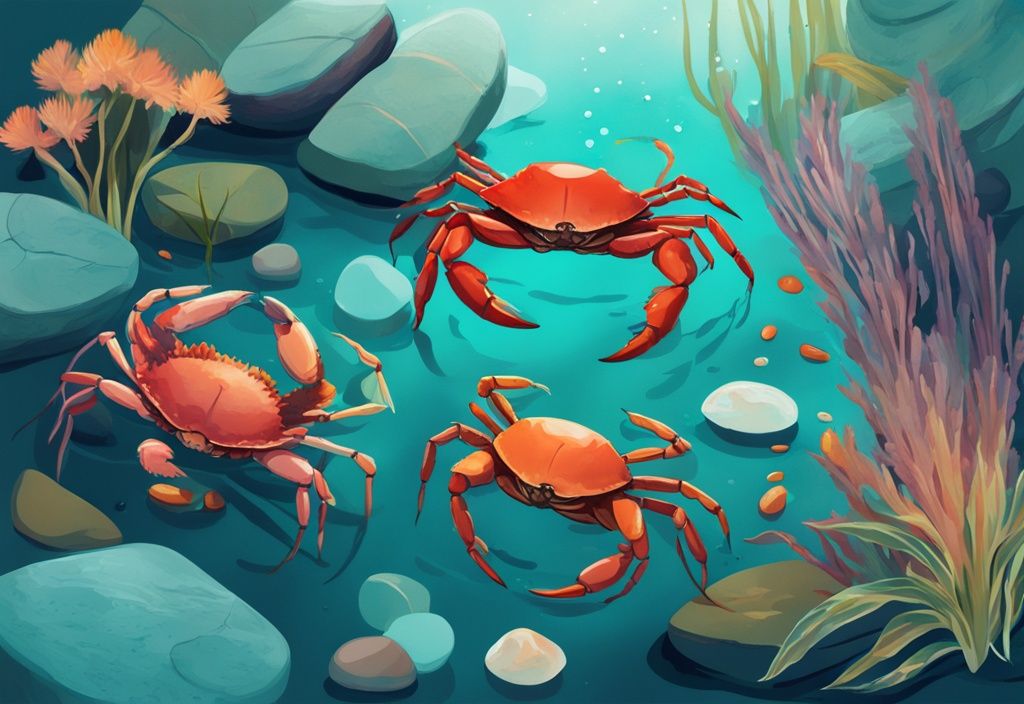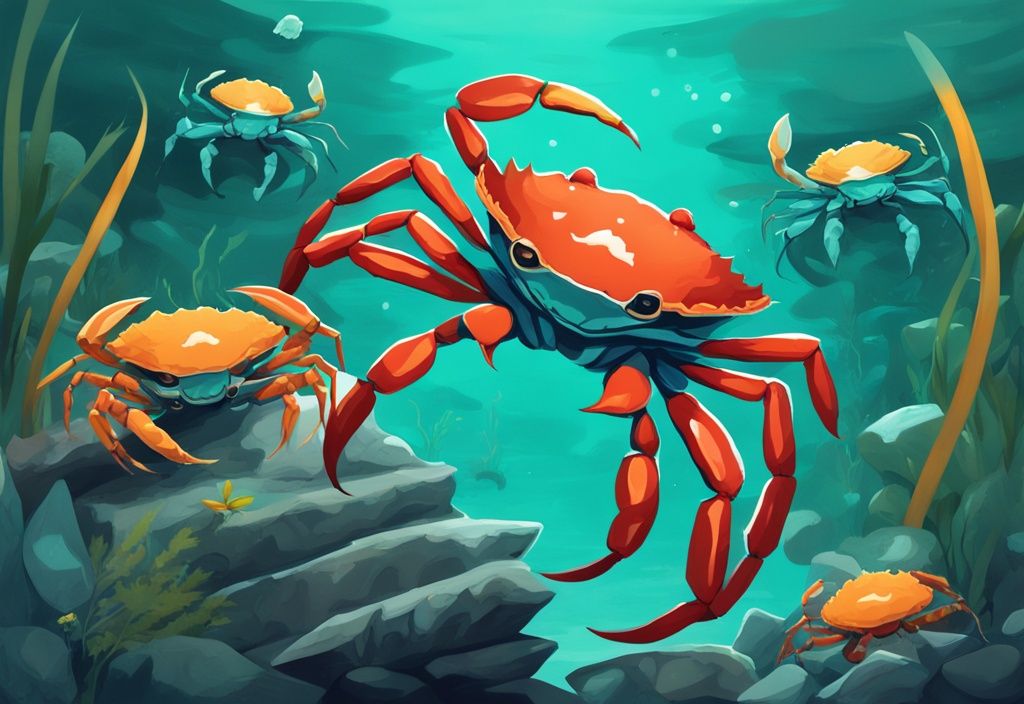Imagine a creature that thrives entirely underwater, navigating the currents with ease and playing a vital role in its ecosystem. Fully aquatic freshwater crabs are such fascinating beings, often overlooked in the world of aquatics. Picture them as the underwater gardeners of their realm, tirelessly maintaining the balance of their watery homes. Did you know that some species can live entirely submerged, unlike their semi-aquatic relatives? This unique adaptation makes them a captivating subject for aquarists and nature enthusiasts alike.
These crabs are not just remarkable for their fully aquatic lifestyle; they boast a range of intriguing physical features and behaviors that set them apart. From their specialized gills to their diverse dietary habits, fully aquatic freshwater crabs are a testament to nature’s ingenuity. Found in various freshwater habitats around the globe, they contribute significantly to the health of aquatic ecosystems.
As we explore the enchanting world of these crabs, we’ll delve into their ecological roles, feeding habits, and the challenges they face in the wild. Whether you’re an aquarist looking to add a new species to your tank or simply curious about these underwater dwellers, this guide promises to equip you with valuable insights and practical care tips.
Join us as we uncover the mysteries of fully aquatic freshwater crabs and learn how to create a thriving environment for them in captivity. Ready to dive deeper into their world? Read on to discover more about these extraordinary creatures and how you can contribute to their conservation.
What are Fully Aquatic Freshwater Crabs?
Fully aquatic freshwater crabs are a captivating group of crustaceans that have perfected the art of living entirely in water. Unlike their land-loving relatives, these crabs thrive in freshwater environments like rivers, lakes, and ponds. Their specialized gills are a marvel of nature, allowing them to extract oxygen directly from the water, so they never need to come up for air.
These intriguing creatures can be found in diverse regions across the globe, including Asia, Africa, and South America. Each species has uniquely adapted to its environment, showcasing an astonishing variety of shapes and behaviors. This ability to live fully submerged makes them a subject of fascination for scientists and aquarium hobbyists alike.
Their adaptation to freshwater habitats is a testament to their evolutionary prowess, enabling them to fill ecological roles that other crabs cannot. As key players in their ecosystems, fully aquatic freshwater crabs contribute significantly to the biodiversity and health of their aquatic homes.
Physical Features and Adaptations of Fully Aquatic Freshwater Crabs
Fully aquatic freshwater crabs are truly captivating creatures, often smaller than their ocean-dwelling relatives. Most species are less than 2 inches in diameter, making them a delightful choice for aquarium enthusiasts. Their compact size is paired with a stunning variety of colors and shell patterns, adding a splash of beauty to any aquatic environment. These crabs have specialized gills, a fascinating adaptation that allows them to extract oxygen directly from water, enabling them to live fully submerged without needing to surface for air.
The physical adaptations of these crabs are finely honed to support their aquatic lifestyle. Their bodies are designed for efficient burrowing and scavenging, two behaviors essential for their survival in the wild. Imagine them as tiny, underwater explorers, equipped with strong, agile legs that help them navigate different substrates. This mobility allows them to thoroughly explore their environment.
Their claws serve a dual purpose. Not only are they tools for defense, but they’re also vital for foraging. These crabs use their claws to sift through sediment and debris in search of food, ensuring they remain well-fed. This combination of physical traits ensures that fully aquatic freshwater crabs thrive in their underwater habitats, making them a unique and captivating addition to any freshwater ecosystem.

Understanding the Behavior of Fully Aquatic Freshwater Crabs
Fully aquatic freshwater crabs are truly fascinating creatures, perfectly adapted to their underwater homes. Imagine them as the architects of their environment, tirelessly burrowing to create shelters and hiding spots. This behavior not only provides them with protection but also aerates the substrate, ensuring a healthier ecosystem. Their scavenging habits are equally important, as they sift through detritus and organic matter, playing a vital role in keeping their surroundings clean.
Territoriality is another intriguing aspect of these crabs. Despite their small size, they can be surprisingly feisty when it comes to defending their territory. Picture a tiny warrior, fiercely guarding its space to secure resources and shelter. This territorial behavior is crucial for their survival, as it guarantees access to food and breeding grounds.
Adding to their charm, fully aquatic freshwater crabs have lively personalities. They’re like the social butterflies of the aquatic world, constantly exploring and interacting with their tank mates. This makes them a favorite among aquarium enthusiasts who enjoy watching dynamic and engaging creatures.
One of the most captivating aspects of these crabs is their unique mating process. The male deposits sperm into a specialized receptacle in the female, allowing her to fertilize her eggs later. This clever adaptation ensures successful reproduction in their aquatic environment, where external fertilization might not be as effective. Such strategies are key to their survival in the diverse and often challenging conditions of freshwater habitats.
Ecological Role of Fully Aquatic Freshwater Crabs in Aquatic Ecosystems
Fully aquatic freshwater crabs are like the unsung heroes of aquatic ecosystems. Imagine them as the diligent janitors of their watery worlds, tirelessly working to keep things tidy. By munching on decaying plant material and leftover food, these crabs act as natural recyclers. Their scavenging not only prevents waste buildup but also plays a crucial role in nutrient cycling. This process is vital for the growth of aquatic plants and the overall health of the ecosystem.
But wait, there’s more! These crabs are also key players in the aquatic food web. They provide a tasty snack for larger creatures like fish and amphibians. This predation helps maintain the delicate balance of species, ensuring that crab populations don’t get out of hand and providing essential nourishment for other organisms. Thanks to these crabs, the biodiversity of their habitats flourishes, creating a more resilient and dynamic ecosystem.
In their quest for food and shelter, fully aquatic freshwater crabs often engage in burrowing and foraging. This behavior can transform their environment, creating microhabitats that benefit other aquatic life. Think of it as a crab-led home makeover, increasing the availability of cozy nooks and breeding sites for various species, and further boosting biodiversity.
The ecological contributions of these crabs highlight the importance of conserving their natural habitats. Protecting these environments from pollution and habitat destruction is essential to ensure the survival of these industrious creatures and the continued health of the ecosystems they call home.
Where to Find Fully Aquatic Freshwater Crabs: Natural Habitat and Distribution
Fully aquatic freshwater crabs are fascinating creatures that thrive in a variety of freshwater environments, such as rivers, lakes, and ponds. These habitats are like bustling cities for crabs, offering clean, well-oxygenated water and plenty of nooks and crannies to hide in. Imagine a crab’s paradise, where every rock and patch of vegetation serves as a cozy home or a strategic hideout from predators.
These crabs are true globetrotters, with their natural distribution stretching across continents like Asia, Africa, and South America. Each region boasts its own unique species, perfectly adapted to their local surroundings. It’s as if each crab has its own passport, stamped with the distinct ecological niche it calls home.
The habitat preferences of these crabs are not just whims; they’re essential for their survival. They seek environments rich in cover, such as rocks and dense vegetation, which offer protection and foraging opportunities. Water quality is another critical factor—think of it as the air they breathe. Pristine conditions are non-negotiable for their well-being, and pollution or habitat degradation can spell disaster for their populations.
Conservation efforts are like lifelines for these crabs, aiming to protect their natural habitats and counteract environmental changes. Initiatives include monitoring water quality, controlling pollution, and shielding ecosystems from human interference. By preserving the health of their habitats, we not only safeguard fully aquatic freshwater crabs but also the rich biodiversity of the ecosystems they inhabit.

Diet and Feeding Habits of Fully Aquatic Freshwater Crabs
Fully aquatic freshwater crabs are fascinating creatures with diverse dietary needs. Understanding what they eat both in the wild and in captivity is crucial for maintaining their health and the health of their ecosystems.
What do Fully Aquatic Freshwater Crabs Eat in the Wild?
In their natural habitats, fully aquatic freshwater crabs are like the janitors of the underwater world. Their omnivorous diet includes algae, detritus, and small invertebrates. This varied menu not only keeps them healthy but also helps maintain the cleanliness of their surroundings. By munching on decaying organic matter, these crabs play a vital role in keeping their ecosystem balanced and thriving.
Some species have taken on the role of filter feeders, using their specialized appendages to capture tiny microorganisms. This adaptation not only adds variety to their diet but also enhances their ecological contribution. Imagine them as tiny vacuum cleaners, sifting through the water to keep it clean and clear.
Feeding Fully Aquatic Freshwater Crabs in Captivity
When it comes to keeping these crabs happy and healthy in captivity, variety is the spice of life. A balanced diet is key, and it should reflect their natural food sources. Think of it as crafting a gourmet menu that includes fish flakes, brine shrimp, and insects. Adding invertebrate pellets and algae wafers ensures they get all the nutrients they need.
Proper feeding practices are essential to prevent any crabby quarrels in the tank. By providing a diverse diet, you not only keep the peace but also get to enjoy their lively personalities and unique behaviors. If you’re dealing with tank maintenance, you might also be interested in learning how to manage and eliminate algae in a fish tank. It’s like hosting a dinner party where everyone leaves satisfied and in good spirits.
Remember, catering to their dietary needs is not just about keeping them alive; it’s about creating a harmonious environment where both you and your crabs can thrive.
How to Care for Fully Aquatic Freshwater Crabs
Setting Up the Perfect Aquarium
Creating a thriving home for fully aquatic freshwater crabs is like crafting a miniature underwater paradise. Picture this: a tank that mirrors their natural habitat, with nooks and crannies made from rocks and lush vegetation. These crabs are the Houdinis of the aquatic world, so a secure lid is a must to keep them from staging a great escape. Each species is a unique character with its own set of needs, so dive deep into research to tailor their environment perfectly. Clean, well-oxygenated water is their lifeline, essential for keeping them healthy and vibrant.
Ensuring Water Quality and Maintenance
Water quality is the unsung hero in the care of fully aquatic freshwater crabs. Think of it as the foundation of their well-being. Regularly checking and maintaining water conditions, like pH levels and temperature, is akin to giving them a spa day. A robust filtration system acts as their personal housekeeping service, keeping the water pristine and toxin-free. And don’t forget about oxygenation—it’s like a breath of fresh air for them, crucial for their respiratory health and overall longevity.
Choosing Compatible Tank Mates
When it comes to selecting tank mates for your fully aquatic freshwater crabs, think of it as casting for a peaceful ensemble in an aquatic play. Choose companions like dwarf shrimp and small fish that are known for their easygoing nature. However, some crab species, such as the Tanganyika Crab, might prefer a solo act due to their omnivorous tendencies. Understanding the personality and behavior of each crab species is key to avoiding drama and ensuring a harmonious community tank.
Popular Species of Fully Aquatic Freshwater Crabs
Exploring the world of fully aquatic freshwater crabs opens up a fascinating realm of biodiversity. Each species brings its own unique charm and requirements to the aquarium, offering aquarists a chance to create dynamic and balanced ecosystems. Below, you’ll find some of the most intriguing species that thrive in freshwater environments.
Thai Micro Crab (Limnopilos Naiyanetri)
The Thai Micro Crab is a captivating little creature, celebrated for its tiny size and unique filter-feeding behavior. These crabs, often less than an inch long, are a favorite among aquarists due to their peaceful nature and fascinating feeding habits. Imagine them as the gentle giants of the micro world, using specialized appendages to sift through water for microorganisms. Their small size and delicate nature mean they need a well-maintained tank environment to truly thrive.
Pom Pom Crab (Ptychognathus Barbatus)
The Pom Pom Crab is easily recognizable by the distinctive filter hairs on its claws, which resemble charming pom poms. This feature not only adds to its allure but also aids in capturing food particles efficiently. Generally peaceful, these crabs can coexist with other non-aggressive tank mates. Their striking appearance and intriguing behavior make them a delightful addition to any aquarium, adding a touch of uniqueness and charm.
Tanganyika Crab (Platythelphusa Sp.)
Hailing from the depths of Lake Tanganyika, the Tanganyika Crab thrives in very specific conditions. Living at depths of 5 to 30 meters, they are not ideal for community tanks due to their specialized habitat needs and potential aggression. These crabs require a carefully controlled environment that mimics their natural habitat, complete with specific water parameters and ample hiding spaces. Their deep-water adaptations make them a fascinating subject for dedicated aquarists.

Panther Crab (Parathelphusa Pantherina)
The Panther Crab is known for its striking appearance and territorial nature, often necessitating larger tanks to accommodate its behavior. Highly active and sometimes aggressive, they are less suitable for community tanks with smaller or more passive species. Their vibrant coloration and dynamic presence make them a standout addition to any aquarium, provided their space and environmental needs are met. Proper tank setup and careful monitoring are key to ensuring their well-being.
Matano Crab (Syntripsa Matannensis)
The Matano Crab stands out for its larger size and aggressive, predatory nature. This species demands a spacious tank environment and should be kept with caution due to its potential to prey on smaller tank mates. Their robust nature and striking appearance make them a captivating choice for experienced aquarists who can provide the necessary care and conditions. Understanding their behavior and dietary needs is crucial for maintaining a healthy and balanced aquarium ecosystem.
Challenges and Conservation Efforts for Fully Aquatic Freshwater Crabs
Fully aquatic freshwater crabs are fascinating creatures, yet they face significant hurdles that jeopardize their existence. One pressing issue is the overfishing driven by the pet trade. As these crabs become more sought after by aquarium lovers, their natural populations are dwindling. The allure of rare and exotic species often leads to unsustainable harvesting, which can severely impact their numbers and disrupt local ecosystems.
Another formidable challenge is habitat destruction. The rivers, lakes, and ponds that these crabs call home are increasingly threatened by human activities. Urban expansion, agricultural practices, and industrial development encroach upon these vital habitats, leaving less room for the crabs to thrive. Moreover, pollution from chemicals and waste further deteriorates their environments, affecting their health and survival.
Conservation efforts are critical to safeguarding these unique creatures and their ecosystems. Various organizations and researchers are actively working to protect their populations. Strategies include creating protected areas, advocating for sustainable harvesting, and raising public awareness about the importance of aquatic conservation. Supporting these initiatives is key to ensuring the long-term survival of fully aquatic freshwater crabs.
Research plays a pivotal role in these conservation efforts. Scientists are continually discovering new species and learning about the ecological roles and adaptations of fully aquatic freshwater crabs. This knowledge is crucial for crafting effective conservation strategies and understanding how these crabs contribute to the health and biodiversity of aquatic ecosystems.
Preserving the natural habitats of fully aquatic freshwater crabs is essential for their survival and the maintenance of biodiversity. Efforts to curb habitat destruction, control pollution, and regulate the pet trade are vital steps in ensuring these intriguing creatures continue to thrive. By prioritizing conservation, we can help maintain the delicate balance of aquatic ecosystems and support the diverse life forms that rely on them.
FAQ
How do Fully Aquatic Freshwater Crabs Breathe Underwater?
Imagine having the ability to breathe underwater without ever needing to come up for air. That’s exactly what fully aquatic freshwater crabs do, thanks to their specialized gills. These gills are marvelously efficient at extracting oxygen from the water, allowing the crabs to remain submerged indefinitely. It’s a bit like having a built-in scuba tank, but much more elegant and natural.
Can Fully Aquatic Freshwater Crabs Live with Fish?
Absolutely, these crabs can share their watery world with fish, as long as the fish are peaceful and non-aggressive. It’s all about creating a harmonious community. However, it’s crucial to consider the specific species of crab and their temperament. Just like people, some crabs are more social than others, so a little research goes a long way in ensuring a peaceful tank environment.
How to Set Up a Tank for Fully Aquatic Freshwater Crabs?
Setting up a tank for these fascinating creatures is like crafting a miniature ecosystem. Start by providing plenty of hiding spots, as crabs love their privacy. Choose tank mates wisely to avoid any territorial disputes. Secure lids are a must, as crabs are notorious escape artists. Keep the water clean and well-oxygenated, with a stable pH and temperature. Think of it as creating a comfortable home where your crabs can thrive and display their natural behaviors.
Conclusion
Fully aquatic freshwater crabs are truly captivating creatures, celebrated for their unique adaptations and intriguing behaviors. These crabs have evolved to thrive entirely underwater, equipped with specialized gills that allow them to extract oxygen directly from their aquatic environments. Their small size and vibrant appearances make them a popular choice among aquarium enthusiasts. These crabs are appreciated not only for their low maintenance requirements but also for the lively dynamics they bring to freshwater tanks.
Beyond their charm in the aquarium trade,
